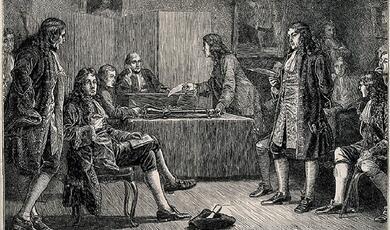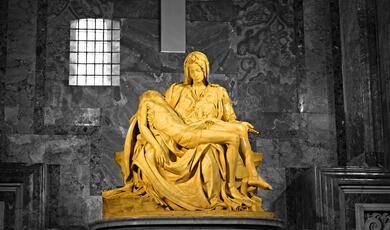The Value of Heritage and the Heritage of Value
Share
- Details
- Text
- Audio
- Downloads
- Extra Reading
There was a time when old places were valued simply for their beauty and interest. Since the 1980s, for many, this is not enough. There is now a whole industry calculating the financial contribution of our history to everything from climate change to health. Have these calculations added to the value of our heritage or have they fundamentally devalued it. Is it time to develop a new argument as to why we should care about our historic environment?
Download Text
8 March 2017
The Value of Heritage and the Heritage of Value
Professor Simon Thurley
There was a time when old places were valued simply for their beauty and interest. Since the 1980s, for many, this is not enough. There is now a whole industry calculating the financial contribution of our history to everything from climate change to health. Have these calculations added to the value of our heritage or have they fundamentally devalued it. Is it time to develop a new argument as to why we should care about our historic environment?
Tonight I would like to reflect on a question that exercises many who are involved in cultural heritage across Europe – what should the relationship be between the state and the individual? In a world where the vast proportion of cultural heritage is in the ownership of private individuals what is the role of the state? Should the state have a role; and if so what should that role be?
I intend to dispatch the first question fairly quickly as in every single European country, indeed in almost every country in the world, the state does intervene in privately owned heritage. It does so on different terms and under different laws - but intervene it does.
In 2013 EH celebrated the centenary of the British government’s direct involvement in heritage. And it is worth considering, for a moment, why the British government began to take this interest. In my recent book Men from the Ministry I argue that it was twofold: market failure and education.
By market failure I mean the inability of individuals to continue to preserve places that had a value not only to the owner but to society as a whole. This had become an increasing problem from the agricultural depression of the 1870s. Increasingly, landowners with major medieval monuments in their parks and gardens found that they could not afford to maintain them as follies or as public curiosities and they began to look to the state to take them on and maintain them. So Rievaulx Abbey that came into State care in 1917 was a public asset in private ownership where the private individual could no longer afford to keep the thing standing.
The second reason for state intervention in heritage was education. Learning about history can be a source of personal enjoyment but it becomes a desirable objective for society as a whole when it is linked to the promotion of national identity and social cohesion. In 1913 a sense of Britishness was seen as an important political objective in the face of challenges to national power and identity from Germany and America. The origins of the 1913 Ancient Monuments Act were as much in the department of education as the Ministry of Works.
Interestingly these two arguments for state involvement in heritage remain as important as ever today. Of course the first of these is the justification for the listed building and scheduled monument legislation: i.e. private owners making changes to buildings or monuments that have an impact on the identity, beauty and economy of the wider community. The main response to this is regulation through the planning system but there is also an argument for public investment where private investment alone would be uneconomic in other words grants from the state.
In addition to this, heritage is conserved for future as well as current generations but the market, of course, cannot ask future generations to pay. While it is true that politicians have a notoriously short term view, intergenerational impacts and benefits are precisely why the government needs to be involved. Similarly the wider historic landscape of an urban or rural area (the public realm) is a public good, i.e. something which cannot be charged for but which is valued by the public.
All these are arguments for state intervention in privately owned assets, and all are justified by the failure of normal private enterprise transactions to provide them. The other argument for state intervention; if you like, the ‘education’ argument also remains pertinent. Today a sense of Englishness is becoming more important against a background of increasing devolution. The history of the place we all share by living in it can help build a common interest across different communities. There is an argument for the state to support broader access and participation in order to achieve these objectives. In Scotland and Wales these arguments have been recognised: heritage funding per capita in the home countries is in the ratio of 9:5:2 (Scotland:Wales:England). The high level of Scottish investment in heritage over the last few years illustrates well the linkage between identity and state intervention.
In addition to the two original reasons for state involvement, since the Second World War some new reasons have become important. The first of these is tourism. In recent years the inextricable link between heritage and tourism has been well made. However, while that is an argument for its value, it does not necessarily mean the state should fund it. The recent history of state support for the national tourist bodies is dismal and shows that politicians generally believe that tourism can be supported by the market with minimal state intervention. Visitors are generally very happy to pay admission charges to the attractions popular with tourists – and attractions are keen to promote themselves. The argument is stronger for state investment in the historic aspects of the public realm of places popular with tourists. So you might argue that the streets of Bath should be funded by the local authority in support of Bath’s tourist appeal.
This argument is very closely connected with the wider one of place. This is to say that places that are attractive and have a depth of history and heritage tend to be successful places to live and work; places that attract tourists and external investment. It can be argued that the state has a role to play in co-ordinating and, where necessary, enforcing and paying for the special historic qualities of places to keep them distinctive and attractive.
The most recent argument for state intervention in heritage is wellbeing. In recognition that culture and heritage will not lead to hundreds of thousands of new jobs and businesses, in England the DCMS is trying to make the case that it is important for wellbeing, which is a current Government priority. This has its origins in Richard Layard’s promotion of the idea of happiness as a measure of success for a country, rather than just the level of economic development (as people getter richer they don’t necessarily get happier). Heritage contributes to mental health and the quality of the environment, both determinants which impact on happiness. Recent work by DCMS and English Heritage has focused on trying to monetise wellbeing benefits. This provides a unit to measure the relative impact of different interventions rather than justifying particular levels of investment. Research published in this the 2014 Heritage Counts shows that visiting heritage has the same impact on wellbeing as £1,646, more than playing sport (around £1,000) and participating in the arts (£1,150).
So ladies and gentlemen, in short these arguments for state involvement, between them, have sustained a degree of investment in the nation’s heritage since the war. However, as the example of wellbeing shows the DCMS, and indeed most cultural bodies, are searching for ways to reinforce their claim to Government funding. Likewise private owners represented by the Historic Houses Association the Country Landowners Association, as well as the amenity societies argue vociferously for tax breaks, grants streams and favourable legislative frameworks.
Various approaches have been taken to arguing for state support for heritage and I now want to turn to these and ask how effective have they been in arguing the case for state support.
Let me start with the first of these, Instrumentalism. The notion that the policy justification for a particular course of action might primarily lie in its positive economic impact is, of course, not new. However its modern history originates with Mrs Thatcher’s Government. Indeed the creation of English Heritage in 1983 can be seen as part of a trend to make supposedly unproductive parts of government more business-like and efficient and therefore beneficial to the economy.
This business-like attitude to heritage was part of a general ‘industrialisation’ of society and economy in the 1980s. It was then that the tourist ‘industry’, the leisure ‘industry’ and the heritage ‘industry’ were born. The Conservative industrialisation of culture continued after the 1992 election with John Major’s creation of a new department of state, the Department of National Heritage. The DNH was created with exactly the same objectives as English Heritage had been - as a way of properly managing and making accountable a group of broadly similar activities. In fact, in 1992, the national heritage, which included museums, galleries, sport and the media, was effectively made into a new state-run industry.
In 1995, as leader of the opposition, Tony Blair went to Australia where he was impressed by the Labour Prime Minister, Paul Keating’s, cultural policy called Creative Nation. The essence of this was the commodification of culture so that its economic and social impact could be measured and then selectively supported by the state to boost the national economy. When Mr Blair got back the Shadow Secretary of State for Heritage, Jack Cunningham, was asked to look at copying Australia’s big idea for culture. Cunningham did not get the job in 1997; it was handed to the former health shadow Chris Smith whose job it was to implement the Creative Nation ideas.
After New Labour’s win in 1997 the Department of National Heritage was renamed the Department for Culture Media and Sport – the DCMS. This was not only a re-branding - it represented a genuine change of direction. Smith published A New Cultural Framework in 1998 which explained that, what were now re-branded as the ‘creative industries’, were a new growth sector in the economy both nationally and globally and, against a decline in traditional manufacturing industries, were a future source of employment and wealth creation. In other words new labour monetised both the products of the nationalised ‘industry’ that the Tories had created and the private businesses regarded as being ‘creative’.
After seven years in power there began to be signs that New Labour policy towards culture might be shifting. This was because despite DCMS getting substantial increases in grant, the Department was felt to be falling behind other parts of Government in arguing for its slice of the cake. In 2004 Tessa Jowell, Chris Smith’s successor as Secretary of State, published an essay looking at the relationship between Government and the bodies in her Department. In it she wrote that ‘too often politicians have been forced to debate culture in terms only of its instrumental benefits to other agendas and that we need to find a way to demonstrate the personal value added which comes from engagement with [culture]’.
Tessa Jowell never translated her views into policy, perhaps partly because of the force of Treasury opinion against her. But her successor had the potential to be much more successful. In June 2007 James Purnell became DCMS Secretary of State. From the start he rejected the instrumentalist approach to measuring cultural activity. In his second month in post he asked Sir Brian McMaster, former Director of the Edinburgh Festival, to undertake a review to see how it might be possible to move the discussion about public subsidy from ‘measurement to judgement’, from a culture of target setting against economic outcomes to a new emphasis on excellence. In January 2008 McMaster Reported. The same month Purnell was reshuffled to the Department of Work and Pensions and the report was buried.
The 2010 election brought in a solidly Tory group of ministers at DCMS. Jeremy Hunt’s Heritage and Tourism Minister John Penrose made a speech on one of his first engagements at Chiswick House arguing that heritage was important for itself and not just for the economic effects that it made. But both he and his boss were overwhelmed by the financial crisis and the cuts that they had to impose. Hunt’s successor Maria Miller returned to the instrumentalist camp and gave her first speech in April 2013; it was called Testing Times: Fighting culture’s corner in an age of Austerity. In it she argued from a purely instrumentalist point of view that cultural bodies needed to make a better economic case for their existence. Like Tessa Jowell, but faster, she soon learnt that this approach got her nowhere. In January 2014 she gave her second speech this was called What Makes our Hearts Sing in which she argued that more than economic arguments were needed to justify state funding on culture.
So, since 1997, culture secretaries have seen the way to get culture taken seriously is to properly take into account the economic benefits of heritage. The argument goes: if we compile a dossier of data that demonstrates the positive effects of heritage on the economy (and therefore on society) it will be given greater weight in decision-making processes. Eleven years ago, in response to this view, English Heritage started an annual compilation of economic data: Heritage Counts. Each year it brings together research on the value and performance of heritage and published it. For instance we now know that in the UK heritage based tourism directly accounts for £5bn in GDP and 134,000 jobs. We know that the businesses based in heritage buildings in the UK contribute £47bn in GVA and over 1.4m jobs. We know that individual companies based in listed buildings contribute, on average 4.4% higher GVA than companies in unlisted premises.
But there is a fatal flaw in this sort of instrumentalism. This is quite simply that everybody is at it. In the area of health it has been calculated that in the UK, treating diseases directly caused by smoking produces medical bills of more than £5bn a year which in 2005-06, equated to 5.5% of the entire National Health Service budget. Diseases relating to Alcohol abuse cost £3bn, but add absenteeism, unemployment, premature deaths and alcohol-related crimes and accidents the total cost of excessive drinking is £6 billion. These figures alone are much more likely to influence policy than any figure calculated for the beneficial effects of cultural heritage.
This has not, of course, stopped people trying. The HUNT study in Norway shows that participation in receptive and creative cultural activities was significantly associated with good health, good satisfaction with life, low anxiety and low depression. In the UK the Heritage Lottery Fund has shown similar benefits from heritage volunteering. But compared with giving up smoking or excessive consumption of alcohol these figures are irrelevant.
So let’s move beyond instrumentalism to another very fashionable argument for heritage – Sustainable Development. Sustainable Development was a term used most powerfully in 1987 by the Brundtland Commission, which coined what has become its most often-quoted definition: ‘development that meets the needs of the present without compromising the ability of future generations to meet their own needs’. This idea was developed during the 1980s and Sustainable Development is now accepted as a principle globally. In December 2009 the European Council confirmed that ‘Sustainable development remains a fundamental objective of the European Union under the Lisbon Treaty’. As emphasised in the Presidency's report on the 2009 review of the Union's Sustainable Development Strategy, it will continue to provide both a long term vision and an overarching policy framework for all Union policies and strategies.
Sustainable Development is most frequently expressed in terms of three dimensions or pillars which are economic growth, social inclusion and environmental balance. Now inevitably, the concept of sustainable development has been challenged. Some think the whole idea is too vague to be useful as an organising concept for policy making. Others respect its usefulness but see the three pillars as inadequate to capture the concerns of society. In particular it has been argued that the three pillars ignore the powerful role that culture plays.
In 2001 the Australian writer Jon Hawkes, argued in his book The Fourth Pillar of Sustainability: Culture’s Essential Role in Public Planning that the model for Sustainable Development should be re-drawn with a fourth pillar added, being culture. This argument has been developed by two groups in particular, Culture 21 and United Cities and Local Governments and has found some sympathy in recent statements by UNESCO as well as in an EU funded Network of Excellence Sustainable Development in a Diverse World.
The original Brundtland Commission and its definition was driven by concern about the use of resources, about not using up more than our fair share of irreplaceable resources, including rainforests as well as fossil fuels - conserving resources for future generations so that they can meet their needs as well as we can; a sort of intergenerational equity. Our heritage is also an irreplaceable resource - like a rainforest, once it's gone, it's gone forever.
A few countries have built the principle of the fourth pillar into economic policy. England is in advance of many because thanks to the efforts of English Heritage, the UK government has built the fourth pillar into its national planning framework. Since 2012 building development that does not respect and enhance heritage is now categorised as unsustainable.
Despite the UK National Planning Policy Framework containing the principle of the fourth pillar it has not yet found widespread application in policy as a whole. There are a number of reasons: Firstly governments are generally not yet structured to be able to rise above the limitations of short term political and budgetary cycles and narrow departmental remits to make the kinds of long-term decisions and connected responses that sustainable development demands.
Secondly, it is much more difficult than it was in 2001 to persuade governments that the concept of sustainable development is, indeed, an organising principle: growth, financial recovery and economic resilience are the top priorities for governments almost everywhere. This has led to some governments putting to one side their commitments to sustainable development. And thirdly, the introduction of culture into the equation is seen as an unnecessary complication in an already complex organising idea.
So it has been argued that a way is needed for an argument for heritage that integrates it into macro-economic and social policy. That lifts it out of a narrow category and argues that it should influence mainstream policy. It is possible to do this in economic theory in terms of production factors.
Heritage is normally considered as a cost factor in economics. Maintaining historic buildings, museums and galleries, historic parks and gardens is seen as an absolute cost to the state: one that has no return but is undertaken as a moral duty – the price government’s pay for being seen as civilised. Now obviously this can be argued as being short sighted and at best valid only in the short term. Under a longer term perspective Cultural Heritage can be seen as a special component in the production function of the European GDP, its growth process, competitiveness and ultimately of European society's welfare.
The assessment of heritage as a cost factor echoes the outdated and discredited view of environmental protection. It is now generally accepted that environmental neglect can have severe economic and social impacts which outweigh the corresponding costs of protection. Accordingly, environmental considerations are now mainstreamed into policy and are an integral part of the overall macro- and often also micro-economic production model and calculation.
There have been strong arguments that heritage, too should be considered as a production factor. An obvious example is tourism which owes much of its attractiveness to heritage, be it in historic cities or the countryside. This generates not only significant European tourism, but massive tourism from outside Europe with the corresponding creation of jobs. Even in sun & sea areas (not the main reason people visit Europe), the strength of heritage contributes to a stabilization and diversification of tourism flows, notably off-season.
But it is not tourism alone where heritage is a crucial production and employment factor. Businesses tend to locate in culturally attractive cities and regions, as it is easier to attract key executives and technicians who want to live in attractive, interesting places. The City of London sees its heritage and cultural offer as key to sustaining its position as a world finance centre. This has now spread more widely with the move of hedge funds and boutique financial services moving to Mayfair, principally because it is a relaxed, civilised and beautiful place to do business mixed-in wit galleries and restaurants. The example of R&D intensive companies is a telling one. They have a marked preference to locate in historic areas, in old converted industrial buildings, in places with a techno-hip vibe. The huge success of the re-generated goods yard in King’s Cross London is a prime example of this. Thus heritage enables innovation and enhances the long term competitiveness of the economy.
King’s Cross, along with 100s of other examples, demonstrates that on a more micro level the continued use of Heritage buildings, provided there is scope for re-use, is an important production factor at the local level attracting new business to heritage-rich locations. The Custard Factory in Birmingham is an obvious local example.
Similar considerations are perhaps also valid for important parts of intangible Cultural Heritage. French cuisine, Italian cheese or the Manchester club scene are important reasons either for tourism inflows or for exports. The same is true for European films, or concerts or operas shown in concert halls or theatres: the Edinburgh festival is a prime example.
Finally, and this is not last in order of priority, the rich availability of heritage and services enriches the quality of life of many European citizens and contributes to their well-being, beyond what can be measured in terms of pure income statistics. This is no blinding revelation: it is something that people have known for centuries, a factor that city governments, in particular have exploited systematically. In 1309 the Statutes of the Municipality of Siena attributed to heritage foreign visitors’ happiness and residents’ honour and prosperity, based on beauty, embellishment (decorum), dignity, public pride and public good (publica utilitas).
Once heritage is regarded as a production factor in the economy some significant things begin to change. Obviously it will bring about a significant change in attitude to economic policy, but crucially it makes sense for the private sector to become more deeply involved in exploiting the potential offered by it. The classical model whereby the private sector primarily invests in tourism services such as hotels, restaurants and shops while the public sector invests in historic buildings, museums etc. is then put into question - particularly in a period when the public sector does not have adequate funds to maintain their assets. A more rational approach would consist in the private sector getting more involved in heritage at large, in order to optimize the use of this production factor for its own business model.
As this begins to happen the public sector had to start to adapt its own approach to Cultural Heritage. Rather than considering components like museums as its natural monopoly, it should incentivize the private sector to get involved, as well, through instruments such as tax breaks, differentiated VAT rates, well designed grant programmes, PPP schemes, etc. It should also create an environment encouraging the private sector to invest in heritage.
So production factors is an attractive argument for heritage as it captures the contributions of the state and private investment in a single model. However this is the very weakness of the idea. Since the Second World War there has been a strong view of the boundaries between state and private investment. Heritage is all too often seen as being in the state sector and when the state fails to invest as it increasingly does) blame is laid at the door of politicians rather than an effective transfer of responsibility to the private sector.
So here is an attitudinal problem, a debate about who owns heritage and who should take responsibility for it.
Here we come on to my fourth and final argument for heritage: the commons.
Commons (from the Latin word Communis) dates back to the middle ages as an institutional arrangement for the collective management and property of natural resources, including grazing land, forests, irrigation systems and fisheries. In English it survives principally as a term to describe land held communally for the benefits of a single community. Such common-pool resources, however, have always faced social dilemmas. In particular, resources managed collectively are at risk of overuse, as communal ownership threatens their very existence.
Social scientists have recognised a potential ‘tragedy of the Commons’: in situations where self-interested individuals, acting independently, fail to cooperate and behave in the interest of the whole group's long-term future by depleting the common resource. Solutions to this dilemma are traditionally either public intervention and centralized management, or privatisation and market-based approaches.
Elinor Ostrom, the Nobel winning political economist, pointed out that neither centralized management nor privatisation of the Commons, although viable, provide an ideal solution. Using an analysis of several empirical case studies, she scientifically demonstrated that the tragedy of the Commons is not inevitable: communities can develop a ‘third way of governance’ at community level succeeding in avoiding unproductive conflicts.
Now, this is important because cultural resources, products and services are often presented as Commons. An obvious example is the use heritage for tourism where, for instance, the commonly owned twisting, turning and cobbled streets of York bring benefits for the whole community. Deterioration or destruction of such landscape and its heritage, and underestimation of the value of culture in policy decisions, can be considered as expressions of the ‘tragedy of the Commons’.
This is seen in so many developing countries where historic areas are over exploited thus destroying the very thing that attracted people in the first place. The tragedy of the Algarve where, without consideration of the long-term impacts, the coast was developed for high volume, low cost tourism. I love this Osbert Lancaster cartoon from 1969 that shows a heritage tour of the city of London with the caption ‘that’s St. Paul’s that was’.
Ostrom’s third way of governance is about community cultural responsibility – a way out of the heritage tragedy of the Commons. In fact several recent developments in both European and UK policy have focused on the collective and social dimension of heritage and community-led development. The Heritage Lottery Fund in the UK has been at the forefront of encouraging and financing community heritage schemes and innovative types of governance. While English heritage has launched its Grade II Heritage at risk initiative as an attempt to engage communities with the common heritage. Meanwhile neighbourhood planning represents an attempt by central government to translate responsibility for the Commons to local people.
Localism is therefore a political expression of the idea of the Commons and provides a possible policy vehicle for arguing for responsibility for heritage Commons being transferred to local people. Digital engagement also offers huge possibilities for community involvement in terms of sharing research, information and discoveries. This brings big challenges in how we change our engagement with people.
There are two principal issues with the idea of the Commons. The first is a problem that is similar to that of production factors i.e. a perception amongst people that it is the responsibility of the state to safeguard collective heritage assets rather than the duty of citizens. This can lead to reluctance to take on responsibilities. However the very environment that we strive to protect was originally created by communal and private initiative, rather than planning or state action, and therefore the model should be possible to replicate.
The second problem is the potential clash between the people and the experts that the notion of the Commons represents. If a community want to sweep away heritage of national value as part of their desire to manage their common heritage, experts (i.e. university professors, the amenity societies, English Heritage) and local communities might oppose each other. Let me give you a very current illustration of this.
Many here will know the famous view of Ely Cathedral, the great ship of the Fens, rising up on its knoll above the watery lowlands that surround it. Ely is a major railway junction and the railway divides the town from the A14, meaning that traffic must cross the line at a level crossing and then skirt its suburbs before going west. The local people want to build a bypass that will take the traffic over the line and around the edge of the town. In the process it must bisect the unspoilt water meadows and blot out the famous view of the cathedral. So here the expert view was that it was a catastrophe; the local view is that the bypass would bring nice views of the cathedral as they drove past. So taking the local view, the heritage of the commons might not always produce the right answer.
Several of these arguments are different ways of saying the same thing. Underlying them is a truth nicely put by the Irish political theorist and Philosopher Edmund Burke who described society as a coalition between the living, the dead and the yet to be born. The fact is that people passionately believe that what they are doing will leave a legacy for future generations. Thus our heritage belongs to the living, the dead and the unborn, and we cannot justify its protection, retention or alteration in terms of short-term economics alone.
A more modern way of arguing this is in terms of intergenerational equity. This means that we have a responsibility to conserve resources for future generations and not use more than our fair share (sustainable development). We have a responsibility to the past and the future to steward our resources and protect our ancestors’ legacy for our descendants. Although it’s difficult to pin this down in policy terms, most people, including most politicians, get it (if only because we want to give ourselves some permanence beyond our own lives) and we shouldn’t be afraid of using this as an argument.
Beyond this where do we put our energy? Do we continue to try and compile more and more elaborate data, or do we try and change the nature of the argument? Well, of course we need to do a bit of both, but the current balance of energy may be wrong. We do need to compile economic data for use in the small number of cases when has a chance of influencing the outcome but we should perhaps put more of our energy into changing the nature of the argument.
This would require us to change some of the language that heritage advocates have traditionally used and align it to government objectives. The current government’s core narrative focuses on the economy, fairness and aspiration and Britain’s role in the world. A future government is not likely to make much change to this – though it might express it slightly differently.
So how would this play out in the future? I think that the economic production factor argument is very strong and effective here. Heritage is not an economic input it is an output. I think we need to get politician to think about heritage as part of the nation’s ‘capital’. Just like coal, copper and tine were part of Victorian Britain’s capital today our strong and rich heritage does the same job. This means that we change the language of cultural engagement to speak of investment and return on capital. So in this line of argument have a responsibility not only to protect our heritage for the future but to invest and develop it as part of the economic productivity of the future.
Fairness and aspiration is a major narrative for all political parties and two of the arguments for heritage contribute to reinforcing heritage’s role here. First, the fourth pillar of sustainable development emphasises that policy must have a soul as well as a bottom line. With a sophisticated, articulate populous, in relatively prosperous times, people want more out of their lives than basic economic outputs. It is not a question of development at all costs. In terms of heritage this means keeping a mix of the old and the new – this is the visual definition of our national identity - who we are, where we are and what we are comfortable with.
The second argument is for the Commons. This is about fostering a sense of shared responsibility for the historic environment empowering people to take control of the places in which they live, and therefore their lives. It is about fostering a sense of local and civic pride and ownership – re-creating some of the spirit that created the historic places that we now admire so much.
And finally considering Britain’s place in the World we return to economic production factors which show that Britain is one of the top three destinations in the world for tourism and one of the most attractive places in the globe to base corporate HQs as Britain’s heritage attracts the best of global talent to work here.
So in conclusion, I believe that we need to recast the arguments for heritage in an age of austerity and societal change. Our heritage is not about money and should not be argued for as such. It is about making a prosperous, stable and cohesive society and politicians need to recognise that.
© Professor Simon Thurley, 2017
This event was on Wed, 08 Mar 2017
Support Gresham
Gresham College has offered an outstanding education to the public free of charge for over 400 years. Today, Gresham College plays an important role in fostering a love of learning and a greater understanding of ourselves and the world around us. Your donation will help to widen our reach and to broaden our audience, allowing more people to benefit from a high-quality education from some of the brightest minds.


 Login
Login







